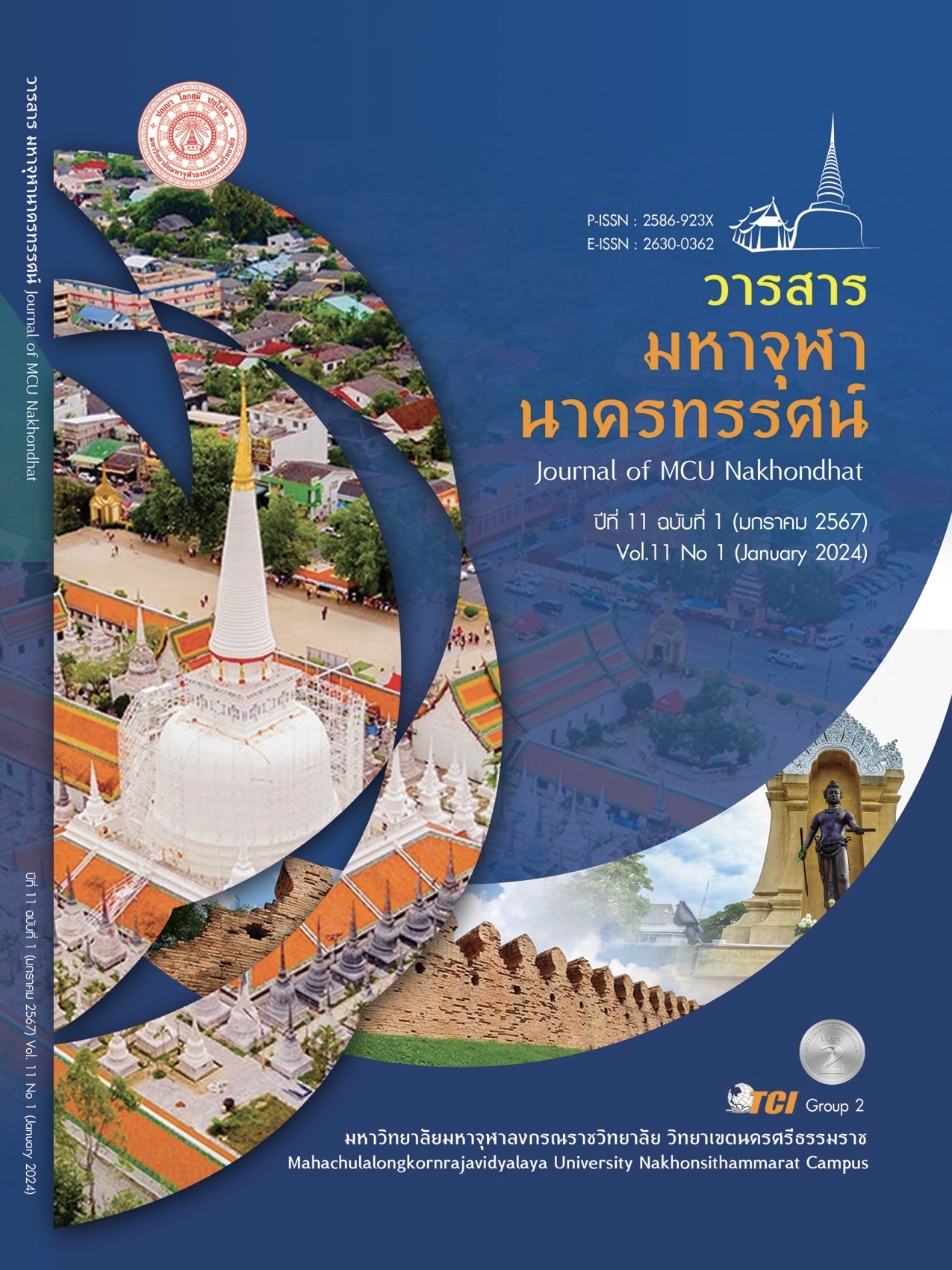ANALYZE THE PROMOTION OF LIVING ACCORDING TO CULTURAL AESTHETIC PRINCIPLES
Main Article Content
Abstract
This research article the objectives are to 1) Study aesthetic theory 2) Study cultural and lifestyle aesthetics 3) Study guidelines for promoting aesthetics. Philosophy major student Religion and culture This research is qualitative field research. By studying from the Buddhist scriptures academic documents and related research the research tool used in-depth interviews. Then present the research results using descriptive analysis. The research results found that: Aesthetics is the study of beauty. which is divided into 2 aspects: natural aesthetics and artistic aesthetics. Cultural aesthetics and lifestyle are living life harmoniously, knowing and understanding the value of traditions and culture of the locality in which you live. which will bring happiness in the lives of oneself and those in society. Guidelines for promoting living according to aesthetic principles for philosophy students Religion and culture Mahamakut Buddhist University Roi Et Campus It is the use of a teaching process that emphasizes students' understanding of beauty theory and aesthetic value. Such as what is beauty? What are the aesthetic elements of beauty? How many criteria are there to judge beauty? When students understand the theory and have students study the beauty from real places from various types of art such as architecture and sculpture. When students understand and are able to explain the meaning and value of various types of art. and various local cultural traditions Upon completion of this subject, students will be able to understand the value of various traditions and cultures more and be able to live their lives with a greater understanding of the value, beauty, and goodness of various environments in society in terms of religious beliefs, culture, and various arts.
Article Details

This work is licensed under a Creative Commons Attribution-NonCommercial-NoDerivatives 4.0 International License.
References
เครือจิต ศรีบุญนาค และคณะ. (2542). สุนทรียภาพของชีวิต. กรุงเทพมหานคร: เธิร์ดเวฟ เอ็ดดูเคชั่น จำกัด.
พระธรรมปิฎก (ป.อ.ปยุตฺโต). (2543). พัฒนาคุณภาพชีวิตด้วยจิตวิทยาแบบยั่งยืน. กรุงเทพมหานคร: มูลนิธิพุทธธรรม.
พระเรืองเดช สิริปญฺโญ. (2557). การศึกษาวิเคราะห์ฮูปแต้มบนผนังสิมวัดป่าเลไลย์ตามหลักสุนทรียศาสตร์. ใน วิทยานิพนธ์พุทธศาสตรมหาบัณฑิต บัณฑิวิทยาลัย. มหาวิทยาลัยมหาจุฬาลงกรณราชวิทยาลัย.
พ่วง มีนอก. (2536). สุนทรียศาสตร์. กรุงเทพมหานคร: ภาควิชาปรัชญาและศาสนา, มหาวิทยาลัยรามรามคำแหง.
ไพฑูรย์ พัฒน์ใหญ่ยิ่ง. (2541). สุนทรียศาสตร์ : แนวความคิด ทฤษฎีและการพัฒนา. กรุงเทพมหานคร: เสมาธรรม.
ยุทธกร สริกขกานนท์ และศันสนีย์ จะสุวรรณ์. (2563). สุนทรียภาพของชีวิต. ใน เอกสารประกอบการสอน สำนักวิชาการศึกษาทั่วไปและนวัตกรรมการเรียนรู้อิเล็กทรอนิกส์. มหาวิทยาลัยราชภัฏสวนสุนันทา.
ราชบัณฑิตยสถาน. (2525). พจนานุกรมปรัชญา ไทย - อังกฤษ ฉบับราชบัณฑิตยสถาน. กรุงเทพมหานคร: ราชบัณฑิตยสถาน.
ศรัณย์ วงศ์คำจันทร์. (2531). ปรัชญาเบื้องต้น คณะวิชามนุษยศาสตร์และสังคมศาสตร์: มหาวิทยาลัยครูกำแพงเพชร. กรุงเทพมหานคร: อมรการพิมพ์.
สถิต วงศ์สวรรค์. (2543). ปรัชญาเบื้องต้น. (พิมพ์ครั้งที่ 2). กรุงเทพมหานคร: รวมสาส์น.
สุจิน สังวาลมณีเนตร และคณะ. (2562). สุนทรียศาสตร์และจริยธรรมในการดำรงชีวิต (ทัศนศิลป์). ใน เอกสารประกอบการสอน. มหาวิทยาลัยราชภัฏบุรีรัมย์.
Biswas - Diener, et al. (2012). Happiness in India. New York: Springer.
Suh, E., et al. (1998). The shifting basis of life satisfaction judgments across cultures: Emotions versus norms. Journal of Personality and Social Psychology, 74(2), 482-493.


